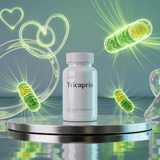Tricaprin: The Fatty Acid Supplement You Didn’t Know You Needed (Until Now)
You’ve probably never heard someone scream, “Bro, you gotta try tricaprin!” at your local gym. That’s because tricaprin isn’t some flashy pre-workout with neon labels and shaky TikTok reviews — it’s a subtle, powerful, and science-backed medium-chain triglyceride (MCT) that’s quietly making waves in the supplement world. Especially the last few days. And that is why the team at Supplement Warehouse wanted to teach you a little bit about Tricaprin.
But like any underdog in a sci-fi story, tricaprin is here to disrupt. And trust me, once you get to know what it does for your heart health, mitochondria, and energy metabolism, you’ll wonder why more people aren’t talking about it.
What Is Tricaprin?
Let’s start with the basics. Sound good? Tricaprin is a medium-chain triglyceride (MCT) made up of three molecules of capric acid (a 10-carbon fatty acid). It’s naturally found in small amounts in coconut oil and palm kernel oil and other MCT oils. But unlike those sources, pure tricaprin supplements deliver a concentrated dose that packs a metabolic punch.
Capric Acid vs Tricaprin: The Quick & Easy Answer
-
Capric Acid = a single fatty acid molecule (C10:0)
-
Tricaprin = a triglyceride made of three capric acid molecules bonded to a glycerol backbone
Think of capric acid as an individual LEGO brick and tricaprin as a full LEGO spaceship made out of three of those bricks attached to a central piece. Get that visual?
Capric Acid (C10:0): The Building Block
Capric acid is a medium-chain fatty acid (MCFA) with 10 carbon atoms. It’s found naturally in:
-
Coconut oil
-
Palm kernel oil
-
Some dairy fat
It’s rapidly metabolized by the liver and used as a quick source of energy, often bypassing normal fat digestion pathways (no bile salts needed, yay!).
Pros:
-
Easily absorbed
-
Can help with energy production
-
Antimicrobial properties
Cons:
-
Irritating in large amounts
-
Rarely used in isolation for supplementation
-
Not very stable on its own
Tricaprin: The Triglyceride Version
Tricaprin is what you get when you take three capric acid molecules and attach them to a glycerol backbone. This makes it a triglyceride, which is how most fats are stored and transported in the body.
Why It Matters:
-
More stable than free capric acid
-
Better targeted for cardiovascular and mitochondrial benefits
-
Used in research studies for things like arterial flexibility, triglyceride metabolism, and energy support
Key Point:
Tricaprin isn’t just “more” capric acid, it's structurally different and acts differently in the body. It's slowly hydrolyzed, providing longer-lasting support for cellular energy metabolism and lipid signaling.
Real-Life Analogy to Help
Imagine capric acid is a fast-burning match: it flares up quickly, gives you a flash of heat, and then it’s gone.
Tricaprin, on the other hand, is a slow-burning log: steady release, controlled energy, and more useful over time.
Final Thought on Capric Acid
So while capric acid is the raw ingredient, tricaprin is the finished product, better delivery, more targeted benefits, and easier to supplement consistently.
If your goal is real metabolic or cardiovascular support, don’t settle for just capric acid in random MCT blends. Go for tricaprin, the science-backed, mitochondria-loving triglyceride your body actually wants to work with.
What Is Tricaprin Used For?
1. Heart Health Hero
One of the most compelling reasons people are turning to tricaprin is for cardiovascular health. A 2023 Japanese study (yes, we read obscure studies for fun) found that tricaprin may help reduce arterial stiffness and promote healthy triglyceride metabolism, which is kind of a big deal for anyone over the age of 30 who’s been surviving on drive-thru burritos and denial.
2. Mitochondrial Metabolism Support
You know mitochondria, the power plants of your cells. Tricaprin acts like a maintenance crew that keeps those cellular engines running efficiently. It bypasses the typical beta-oxidation bottlenecks and feeds right into energy production. This makes it intriguing for people with metabolic conditions or those who just want better energy without stimulants.
3. Weight Management
Some early studies suggest tricaprin might support weight loss and fat metabolism, similar to other MCTs. It gets oxidized quickly in the liver and used as fuel rather than stored as fat, so it’s like giving your body kindling instead of firewood.
What Products Contain Tricaprin?
You’ll mostly find tricaprin in:
-
Tricaprin capsules – Easy to take, no coconut aftertaste. HARD TO FIND LEGIT SOURCES.
-
Tricaprin Max – A high-potency formula aimed at cardiovascular and mitochondrial support.
-
Tricaprin powder blends – Occasionally used in metabolic health stacks.
-
Some cutting-edge heart health supplements that focus on natural triglyceride control.
- MCT and Coconut Oils naturally have this compound in them.
(Searches like tricaprin supplement, tricaprin supplements, and tricaprin max are blowing up right now — so yes, people are catching on.)
Is Tricaprin Found in MCT Oil?
Short answer: Yes — but not always in useful amounts.
Longer, nerdier answer: Tricaprin is a specific type of medium-chain triglyceride (MCT) made entirely from three capric acid (C10) molecules. It's part of the MCT family, but here’s where things get wonky: most over-the-counter MCT oils are blends, and the exact makeup varies wildly.
What's Usually in MCT Oil?
-
Caprylic acid (C8) – The golden child of MCT marketing. Fastest energy, burns hot.
-
Capric acid (C10) – That’s our friend tricaprin’s building block.
-
Lauric acid (C12) – Technically a medium-chain fatty acid, but behaves more like a long-chain one metabolically.
So where’s Tricaprin?
In most MCT oils, you’ll find capric acid (C10) as a component, often making up 20–40% of the formula. But tricaprin, the fully esterified triglyceride form, is rarely isolated or concentrated in these blends. It’s like trying to get pure oxygen from the air. Sure, it’s there…but good luck getting a meaningful therapeutic dose.
If you do want a MCT Oil, we recommend them from Now Foods as shown here.
TL;DR — Should You Just Chug MCT Oil for Tricaprin?
That’s like saying, “I want more protein, so I’ll eat lettuce.” Technically correct (it has trace protein), but not efficient.
MCT oil has its own benefits, energy, gut health, cognitive boost, but if you’re after cardiovascular support, mitochondrial benefits, or targeted metabolic effects, you need pure tricaprin, not a random splash of it hidden inside a bottle of blended oils.
So if your MCT label doesn’t specifically mention tricaprin or C10:0 at therapeutic levels, it’s probably not doing much in that department.
Is Tricaprin Found in Coconut Oil?
Yes. But not in the way you’d hope.
Coconut oil is like the celebrity entourage of the fatty acid world, it knows tricaprin, but it's not giving it the spotlight.
Here’s the Breakdown:
Coconut oil is made up of various saturated fats, including:
-
Lauric acid (C12) – ~45–50% (the diva of coconut oil)
-
Myristic acid (C14) – ~16%
-
Caprylic acid (C8) – ~8%
-
Capric acid (C10) – ~7%
-
Tricaprin (C10:0 triglyceride) – Only in trace amounts, and often not even listed on the label
That means while capric acid is technically present, actual tricaprin — the triester of capric acid, the real metabolic workhorse — is virtually nonexistent in your average coconut oil.
So, Can Coconut Oil Give You the Benefits of Tricaprin?
If you're trying to support:
-
Mitochondrial function
-
Cardiovascular health
-
Triglyceride metabolism
…maybe or maybe not. You’d need to consume an impractical amount to get a clinically meaningful dose of tricaprin and by the time you're on your fifth spoonful of solidified oil, your digestive system may file a formal complaint.
Final Verdict: Don't Count on Coconut Oil for Tricaprin
Coconut oil has its place, antimicrobial properties, cooking uses, DIY hair masks for TikTok influencers, etc. But when it comes to tricaprin benefits, you're far better off going with dedicated tricaprin capsules or formulas like Tricaprin Max that actually give you the dose your cells need.
Let coconut oil be coconut oil. Let tricaprin be the metabolic sidekick you didn’t know you needed. in concentrated, supplement form.
Are There Any Side Effects?
Ah yes, the “what could possibly go wrong?” section.
For most people, tricaprin is well-tolerated, especially in capsule form. But like any fatty acid supplement, taking too much too quickly might cause:
-
Mild digestive upset (read: you might get the runs if you go full cowboy on dosage)
-
Nausea in rare cases
-
Potential allergic reaction if you’re sensitive to coconut or palm-based MCTs
Start low and build up. If you’re stacking it with other MCTs, talk to a professional. Or at least don’t blame the supplement if you take three times the dose and spend the afternoon in the bathroom.
FAQ Time: Tricaprin Questions from Real Humans (Probably)
Is Tricaprin the same as MCT oil?
Nope. While it’s in the MCT family, most commercial MCT oils are blends of caprylic (C8) and capric (C10) acids. Tricaprin is 100% capric acid in triglyceride form, which gives it different properties, especially for mitochondrial and cardiovascular benefits.
Can Tricaprin help with cholesterol?
Emerging research suggests it may help reduce triglycerides and support healthy LDL levels, but it’s not a substitute for statins (unless your doctor is an AI from the future who’s read all the data). Still, it looks promising.
Is Tricaprin good for weight loss?
If your idea of weight loss is sustainable energy, appetite control, and metabolic support, then yes, tricaprin can help. Just don’t expect it to work miracles if your current meal plan involves Pop-Tarts and pizza rolls.
Final Thoughts: Should You Try Tricaprin?
If you’re someone looking for:
-
Cardiovascular support
-
Better metabolic function
-
Natural mitochondrial energy
-
Or just something new that doesn’t come in neon powder form...
...then tricaprin supplements might be exactly what your health stack is missing.
While Supplement Warehouse does not sell Tricaprin-only supplements, we do have a full line of MCT and Coconut Oils here.
†The content of this blog post is intended solely for reference and entertainment purposes. We do not offer medical advice or specific guidance regarding the products discussed. Our insights are based on a combination of anecdotal experiences, online studies/reviews, manufacturer details, and customer feedback. While we strive to present accurate and current information, we cannot assure its completeness or its alignment with the most recent product formulations or data. For any concerns or up-to-date information, we recommend visiting the manufacturer's website directly. The opinions and information provided here do not necessarily reflect the views of Supplement Warehouse; they represent the perspectives and information from the manufacturers and users. Furthermore, these statements have not been evaluated by the Food and Drug Administration. The products mentioned are not intended to diagnose, treat, cure, or prevent any disease or illness.
Recent Posts
-
The Ultimate Guide to Primobolan for Bodybuilders
Science First: What Is Primobolan? First, let's talk about the other one, not the prohormone from H
-
Tricaprin: The Fatty Acid Supplement You Didn’t Know You Needed (Until Now)
You’ve probably never heard someone scream, “Bro, you gotta try tricaprin!” at you
-
Ipamorelin: The Silent Giant of Peptides (And Why Athletes Are Hooked)
Look, you’ve probably heard of growth hormone (like Hi-Tech Pharmaceuticals Protropin). It&rsq






